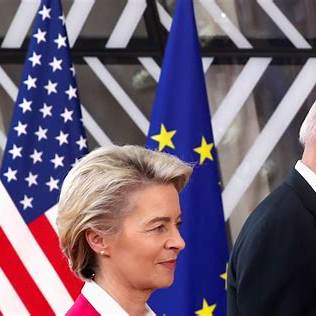US-Europe ‘break’ is changing the world: What’s happening and why?

US-Europe Relations Breakdown: How Trump’s Policies Are Changing the World
The geopolitical landscape is shifting as tensions between the United States and Europe continue to escalate. The US-Europe relations breakdown has been a growing concern, with former US President Donald Trump’s policies playing a crucial role in reshaping global alliances. While some view these shifts as necessary recalibrations of US foreign policy, others warn that they could have long-term consequences for international stability.
US Reverses Stance on Russia-Ukraine War
One of the most significant indicators of the US-Europe relations breakdown is the shifting US approach to the Russia-Ukraine war. The United States, once a firm supporter of Ukraine’s sovereignty and military defense, appears to be reconsidering its position. In what seems like a strategic realignment, Washington has shown signs of engaging with the Kremlin to push for a settlement in Kyiv.
This shift became particularly evident on February 24, the third anniversary of Russia’s invasion of Ukraine, when the US declined to support a UN resolution condemning Russian aggression—a move that surprised and concerned its European allies. While some analysts see this as a pragmatic attempt to de-escalate global conflicts, others argue that it undermines NATO unity and weakens Europe’s security framework.
Key Factors Behind the US-Europe Relations Breakdown
Several major factors are contributing to the increasing rift between the US and its European allies:
1. Gaza Policy Shift
Trump’s controversial proposal regarding Gaza has deepened tensions between the US and Europe. While European nations remain committed to a two-state solution, the US appears to be favoring a more unilateral approach. This divergence in strategy has caused friction, particularly as humanitarian concerns in the region continue to escalate.
2. Ukraine Conflict and NATO Commitments
The US’s refusal to fully support further UN actions against Russia has been a source of frustration for European nations that continue to back Ukraine. Many European leaders fear that Washington’s softened stance could embolden Russia and create further instability in the region. Additionally, Trump’s repeated criticisms of NATO spending by European nations have raised concerns about America’s long-term commitment to the alliance.
3. Trade and Economic Disputes
Beyond military and geopolitical concerns, trade disputes are also straining US-Europe relations. European leaders have expressed concerns about America’s shifting trade policies, which include increased tariffs on European goods and reduced cooperation on economic partnerships. Trump’s “America First” policy often prioritizes domestic economic interests over traditional alliances, creating additional friction in transatlantic trade agreements.
4. Climate Policy and Green Energy Disagreements
Another area of contention is climate policy. European nations have been pushing for stronger commitments to renewable energy and carbon reduction, while the US, particularly under Trump’s administration, has scaled back climate commitments. The US’s withdrawal from global climate agreements, such as the Paris Accord during Trump’s tenure, was seen as a major betrayal by European leaders who view climate change as an urgent global issue.
The Global Impact of the US-Europe Relations Breakdown
The consequences of the US-Europe split could be far-reaching, affecting global diplomacy, military alliances, and economic structures. Some of the key global implications include:
1. A More Independent Europe
In response to US unpredictability, European nations are considering more independent defense and economic strategies. France and Germany have already begun discussions on creating a European military force that would function independently of NATO. The European Union is also exploring stronger economic ties with China and other global powers to reduce dependence on the US market.
2. Weakened NATO Cohesion
If US-Europe tensions continue to rise, NATO’s effectiveness as a military alliance could be compromised. The US has historically been the backbone of NATO, providing military leadership and financial contributions. However, if European nations perceive the US as an unreliable partner, NATO’s future could be at risk.
3. Increased Russian and Chinese Influence
As US-Europe ties weaken, Russia and China are likely to capitalize on the situation. Moscow has already been increasing its diplomatic and economic engagements with European nations that are skeptical of US policies. Similarly, China’s Belt and Road Initiative is expanding its influence in Europe, offering economic partnerships that may shift traditional Western alliances.
Future Scenarios: What Lies Ahead?
The US-Europe relations breakdown is at a critical juncture, and several potential scenarios could unfold:
Scenario 1: A New European Bloc
If tensions persist, Europe may move toward greater autonomy, reducing its reliance on the US for defense and economic support. This could lead to the emergence of a stronger European bloc with increased cooperation among EU nations.
Scenario 2: A Shift Back to Traditional Alliances
A change in US leadership or a recalibration of policies could lead to a renewed commitment to traditional alliances. If a future administration prioritizes restoring US-Europe ties, many of the current fractures could be repaired.
Scenario 3: A Fragmented Western World
In the worst-case scenario, ongoing disputes could lead to a fragmented Western world, where the US and Europe operate more independently, potentially weakening their collective influence on global affairs.
Conclusion
The US-Europe relations breakdown is reshaping the global order, with key shifts in foreign policy, trade, and military alliances. As tensions rise, both sides must navigate these challenges carefully to avoid long-term diplomatic and economic consequences. Whether this marks the beginning of a new era of European independence or a temporary strain in relations remains to be seen, but one thing is clear—the geopolitical landscape will never be the same again.






